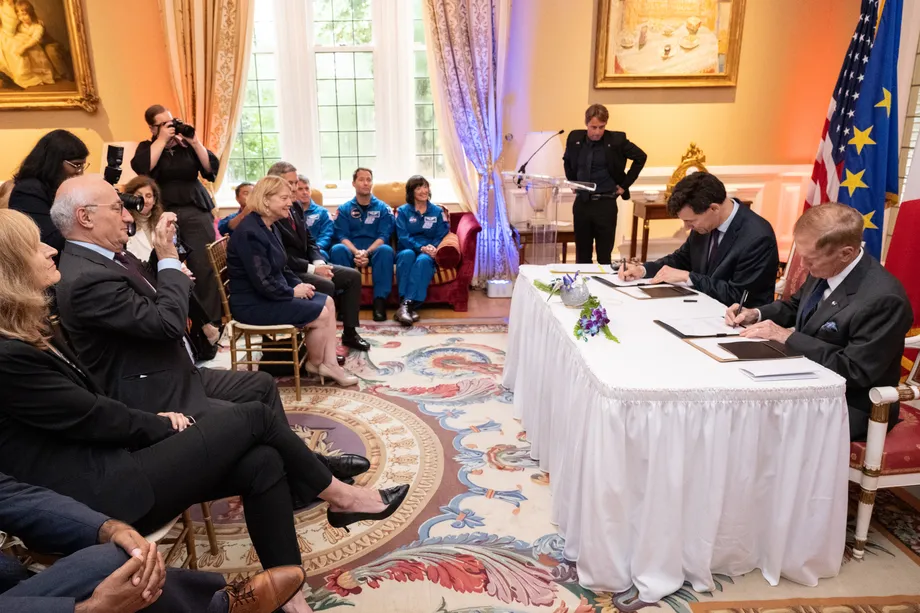According to the verge report, on Tuesday night local time, France officially signed the "Artemis accords" of NASA -- a set of guidelines and principles of NASA on how the United States and other countries should explore the moon in the future. France's accession has long been regarded as a great harvest of the Artemis agreement, bringing the total number of signatories to 20. The international agreement has been strengthened before NASA plans to return to the lunar surface within this decade.

When the trump administration proposed the final Artemis agreement in October 2020, NASA announced that eight countries had signed the document, including the United States. But there are some obvious absences on this list. The world's two largest space superpowers - China and Russia - have not signed, and Russia's space director has made it clear that the country is not interested in cooperating with NASA in lunar exploration. France and Germany, the two largest aerospace countries in Europe, have not joined.
Now, two years later, France has finally come to the negotiating table. It is considered to be the most important signatory to the agreement so far. Gabriel Swiney, NASA's senior policy adviser and one of the original authors of the Artemis agreement, told the verge: "it is very important to put France on the same front with us in lunar exploration and other programs, because they are as dominant as Germany in Europe." France is the largest contributor to the ESA budget. The United States also has a long-term cooperative relationship with the French space agency CNEs, and the country plays a key role in operating launch sites and rockets for Ariana space, a major European launch supplier.
It is reported that France did not fully accept the Artemis agreement at the beginning. Swiney said: "they have always publicly expressed the need to clarify some issues in the Artemis agreement. Now, the country's problems with the agreement seem to have been resolved, making the agreement an important ratification from a once skeptical country."
Although the Artemis agreement is an international document, they are intrinsically linked to NASA's lunar ambitions. The name Artemis comes from NASA's Artemis program, which aims to land the first woman and the first colored astronaut on the lunar surface as early as 2025. Although the timing of this landing may change, NASA believes that it is necessary to reach a pre emptive international agreement with other countries to specify which rules and standards should be applied to lunar exploration before humans land on the moon again. "What we need to do is to establish a code of conduct that every country can agree to," said Jim bridenstine, a former NASA administrator, in 2020. NASA worked with the State Department to propose the final rules.

The Artemis agreement is based on the pillar of international space law, namely, the outer space treaty. The treaty came into force in 1967, creating a loose framework for how countries should explore space. The signatories agreed to explore space peacefully, not claim sovereignty over the moon, Mars and other celestial bodies, nor place weapons of mass destruction in space. However, the design of the outer space treaty is vague, which makes many of its tenets can be interpreted and debated in the past half century.
The Artemis agreement went further, focusing on slightly stricter criteria for exploring the moon. For example, the Agreement establishes an area on the moon called a "safety zone". If a country is working in an area on the surface of the moon, it will notify other signatories and other countries will not interfere in the area. The agreement also calls for the protection of heritage sites, such as the landing site of the Apollo mission, and the "exploitation and utilization" of space resources. In this way, countries can mine materials on the moon and then use them for their lunar exploration.
When the Artemis agreement was first put forward, they received considerable criticism. A major criticism revolves around the use of lunar resources. Some people believe that the agreement is a U.S. scramble for resources in space. Some were of the view that the concept of the use of space resources conflicted with the directive in the outer space treaty that did not require sovereignty over celestial bodies. Swiney said that, in fact, this part was one of France's initial concerns.
"France has always been one of the countries that clearly stated that they believe that space resources are something that the international community needs to really spend some time and think about," he said. "In this way, it will not become a 'Wild Western Gold Rush', or it will not replicate some of the same inequalities we see on earth."
NASA and government officials have worked with the French space agency to try to dispel their misconceptions that space resources are prohibited by the outer space treaty. Finally, France agreed to sign, and NASA will
The Artemis agreement serves as a simple starting point, not the end of the discussion on space resources. According to the agreement, countries can exploit resources, but "you must do it legally. You need to continue to discuss it and solve some of the larger problems". Swiney said, "so I think they realize that this is a good starting point, and then solve the problems that they continue to feel very strong."
The next European power will be Germany, the second largest donor to ESA, and Swiney is optimistic about this prospect. "I think it just takes time for countries to familiarize themselves with the Artemis agreement," he said. "What they heard was not just one U.S. government, but two U.S. governments talking about them... As we advanced the (Artemis) missions, which were really centered on science and exploration, I think people realized that the Artemis agreement was indeed what they claimed, that is, trying to create rules for exploration and science."
Another long-standing criticism of the Artemis agreement revolves around the fact that NASA did not adopt the traditional treaty making process of the United Nations. Swiney said, "I think this concern has really been dispelled just by the signers we get." The Artemis agreement includes a diverse group of non-traditional space faring nations, such as Colombia and Bahrain. With the signing of more countries, the Artemis agreement may become a new framework for future international space agreements - a framework that may be slightly faster and more flexible than the usually slow treaty approach.
"It is an idea that all these things are complementary, and then the Artemis agreement will be fed back to the process of the United Nations," Swiney said. "But at the same time, when we are about to return to the moon and we need rules, we will not sit back and wait for the entire international community to provide guidance."
Swiney said that in the coming months, we should pay attention to more signatories. In addition to Germany, he pointed out that India would be a particularly popular signatory given its strong space program. And soon, once the flight to the moon begins, the Artemis agreement will transition from theoretical policy guidance to implementation, which will eventually be a more difficult part of the process. But so far, the document has won so many supporters, which has been a great victory.
"We know these are the problems that need to be solved before we begin to appear on the moon and beyond, especially in a lasting way," Swiney said. "But we're just not sure if this is something we can accomplish. I think that has really changed since 2020."